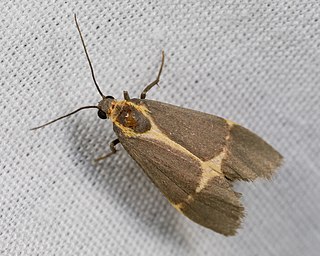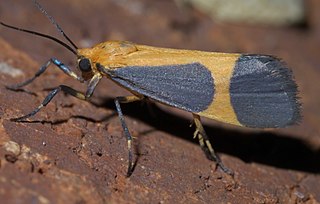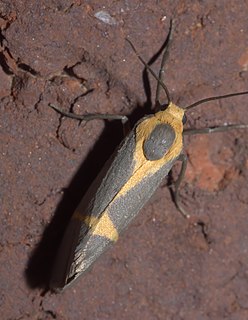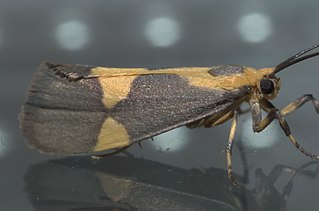
Cisthene is a genus of lichen moths in the family Erebidae. The genus was erected by Francis Walker in 1854.

Cisthene plumbea, the lead-colored lichen moth, is a moth of the family Erebidae. The species was first described by Richard Harper Stretch in 1885. It is found in eastern North America, from southern New Jersey south to northern Florida, west to Wisconsin and Texas.
Cisthene coronado is a moth of the family Erebidae first described by Carroll B. Knowlton in 1967. It is found in the US state of Arizona.
Cisthene martini, or Martin's lichen moth, is a moth of the family Erebidae first described by Carroll B. Knowlton in 1967. It is found in the US states of Arizona, New Mexico and Texas.

Cisthene angelus, the angel lichen moth, is a moth of the family Erebidae. It was described by Harrison Gray Dyar Jr. in 1904. It is found in North America, where it has been recorded from southern Nevada and Utah south to southern Arizona and western Texas.

Cisthene barnesii, or Barnes' lichen moth, is a moth of the family Erebidae. It was described by Harrison Gray Dyar Jr. in 1904. It is found in the US Rocky Mountain region, from southern Montana and western North Dakota to the border with Mexico in Arizona and New Mexico. The habitat consists of dry bunchgrass steppe.
Cisthene conjuncta, the white-streaked lichen moth, is a moth of the family Erebidae. It was described by William Barnes and James Halliday McDunnough in 1913. It is found in southern Texas.
Cisthene deserta is a moth of the family Erebidae. It was described by Felder in 1868. It is found in North America, where it has been recorded from Utah and California.
Cisthene dorsimacula is a moth of the family Erebidae. It was described by Harrison Gray Dyar Jr. in 1904. It is found in southern California, United States.
Cisthene faustinula is a moth of the family Erebidae. It was described by Jean Baptiste Boisduval in 1869. It is found in California.
Cisthene juanita is a moth of the family Erebidae. It was described by William Barnes and Foster Hendrickson Benjamin in 1925 and is found in the United States in southern Arizona.

Cisthene kentuckiensis, the Kentucky lichen moth, is a moth of the family Erebidae. It was described by Harrison Gray Dyar Jr. in 1904. It is found in the United States from New Jersey south to northern Florida, and west to Missouri, Oklahoma, and Texas.
Cisthene liberomacula is a moth of the family Erebidae. It was described by Harrison Gray Dyar Jr. in 1904. It is found along the coast of the US state of California. The habitat consists of areas with coastal live oaks.

Cisthene packardii, or Packard's lichen moth, is a moth of the family Erebidae. It was described by Augustus Radcliffe Grote in 1863. It is found in the US from the states of New York to Florida and from Missouri to Texas. The habitat consists of barrens and dry oak woodlands in the northern part of the range and a variety of woodlands and scrubs in the south.

Cisthene picta, the pictured lichen moth, is a moth of the family Erebidae. It was described by William Barnes and James Halliday McDunnough in 1918. It is found in the United States from Texas to Arizona. The habitat consists of deserts.
Cisthene subrufa, the Tamaulipan lichen moth, is a moth of the family Erebidae. It was described by William Barnes and James Halliday McDunnough in 1913. It is found in the United States in Arizona and from San Benito, Texas south to Veracruz in Mexico.

Cisthene tenuifascia, the thin-banded lichen moth or three-banded lichen moth, is a moth of the family Erebidae. It was described by Leon F. Harvey in 1875. It is found in Mexico and from Arizona to Florida, North Carolina and Oklahoma. Strays can be found further north.

Cisthene unifascia is a moth of the family Erebidae. It was described by Augustus Radcliffe Grote and Coleman Townsend Robinson in 1868. It is found in the southern United States and Mexico.

The Cisthenina are a subtribe of lichen moths in the family Erebidae, currently containing 428 described species.









